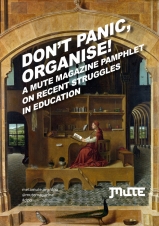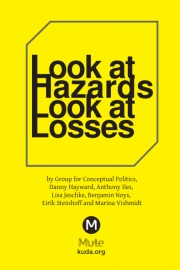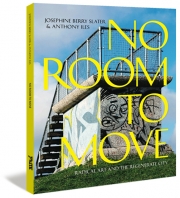Video Negative Positive
Tank tv's DVD anthology of contemporary film and video and the Re:[Video Positive] exhibition at FACT in Liverpool respectively explore the present and past of artist's video. It's come a long way, but where has it arrived? asks Pryle Behrman
In High Art Lite: British Art in the 1990s (1999), Julian Stallabrass noted that: ‘The path from marginal to central is, more often than not, merely a matter of moving work from one context to another.’ Nowhere is this more apparent than in video art. It began life as a counter-cultural force, shown to a handful of initiates in unconventional venues and occupying the very edges of fine art, as it was then understood, and also broadcast television, with which it shared a common technology. As the legend has it, the first exhibition of video art can be traced to 1965, when Nam June Paik bought one of the first Sony Portapak video sets in New York and began recording the Papal entourage which was, that same day, making its way down Fifth Avenue. Later that night Paik showed his footage of the Pope to a small gathering in the smoky confines of Café à Go Go, an artists’ hangout. In the 42 years that have passed since then, video has steadily progressed from the periphery to centre stage. In museums and galleries around the world, cavernous gallery spaces have been stripped of paintings and sculptures to make way for a single video projection. Video has come a long way, but where has it arrived? And, at what cost?
As pointed out through the institutional critiques of Michael Asher, Marcel Broodthaers, Hans Haacke and others in the 1960s, exhibiting a work within a gallery or museum context inevitably changes its reception in ways that can be inimical to the artist’s original intentions. In the case of video, it could be argued that its acceptance into the canon of art has inevitably resulted in the blunting of its critical edge since, as Shirin Neshat recounts in her foreword to Catherine Elwes’ book Video Art, a guided tour (2005), the primary motivation behind video in its early incarnations was the desire to escape the art world as it was then constructed. Neshat believes its development represented ‘artists’ frustration with the exclusivity of art and its audience, their desire to bring art closer to popular culture and to engage more closely with real social and political issues.’ To examine this contention more fully, it seems timely to look at two coeval efforts to promote video as an art form in unconventional ways: Fresh Moves: New Moving Images From The UK, a DVD anthology of contemporary film and video by British-based artists released in June this year by tank.tv, and Re: [Video Positive] Archiving Video Positively, an exhibition currently taking place at FACT in Liverpool that re-stages several works by artists who participated in the six ‘Video Positive’ festivals that occurred in the city between 1989 and 2000.

Image: David Hall, A Situation Envisaged: The Rite II (Cultural Eclipse), 1989 (re-created 2007)
‘Video Positive’ was designed as a showcase for a wide range of contemporary artist’s film and video, often focusing on ground-breaking developments within the field with particular reference to the latest technologies. The first festival in 1989, for example, included a ‘video wall’ composed of forty-two monitors stacked together to form a vast segmented screen. Images on the video wall were controlled by computer so that they could be manipulated to multiply, fragment and shift from monitor to monitor, and new works by Judith Godard, Katherine Meynell and Jeremy Welsh were commissioned specifically for it. This type of technical innovation was typical of ‘Video Positive’, but other elements of the event were more regressive. Although the 1989 incarnation used a number of non-gallery settings provided by the chain of TV shops owned by D.E.R (Rentals) Ltd, the festival did mark the shift of video into institutional environments, since the bulk of the exhibitions took place at the Tate, Bluecoat and Williamson art galleries.
Video Positive could thus be seen as part of a widespread trend that arose fairly rapidly after the birth of video in which galleries and museums sought to absorb this new medium into its programming by emphasising its sculptural qualities above all else, since this would enable the institution (and a significant part of its audience) to henceforth view it as a smooth progression from the art of the past. This impression is reinforced by examining the centrepiece of Re: [Video Positive]: a recreation of David Hall’s A Situation Envisaged: The Rite II (Cultural Eclipse) from 1989. In it a tower of monitors is positioned facing the wall so that their TV broadcasts are ‘eclipsed’ by the back of the sets and their original message transformed into an aura of coloured lights. A single monitor in the centre (the only one whose screen is facing the viewer) shows a flickering 30-line image akin to those used in the very first transmissions of John Logie Baird in the 1920s. The inferences are clear: firstly, that television has come a long way from the scratchy, inchoate images of the early 20th century to the polyphony of sound and image we now have in this multi-channel age, but equally as important is the notion (often recapitulated in gallery installations throughout the 1990s) that TVs can also be beautiful, quasi-minimalist sculptures in their own right.
Image: David Hall, A Situation Envisaged: The Rite II (Cultural Eclipse), 1989 (re-created 2007)
Of course the other impression that strikes you on viewing A Situation Envisaged in 2007 rather than 1989 is how bulky and old-fashioned the monitors now appear. This transformation of David Hall’s work into a historical curiosity is deeply ironic since, as has been mentioned, Video Positive was designed as a paean to new technology. Re: [Video Positive], to its credit, is acutely aware that recreating work from the past raises it own difficulties and has wisely chosen to characterise each exhibit as an evolving rather than a static entity (thus a wall label placed adjacent to A Situation Envisaged highlights that the video content has recently been digitised). The aim seems to be to position Re: [Video Positive] as part of the current fascination with restaging the past, as seen for example in the work of Iain Forsyth and Jane Pollard, who re-enacted a Victorian séance in the nearby St George’s Hall for the 2006 Liverpool Biennial. However, while Forsyth and Pollard were resurrecting an event that was intentionally ephemeral, Re: [Video Positive] is restaging artworks that, in most cases, were envisaged to be a permanent record, but which have been rendered increasingly obsolete by the pace of scientific change. These reconstructions thus create a specific type of poignancy that is both unique to technologically-reliant media such as video art and wholly unintended in the original.
Given these concerns, it would still be overly simplistic, to see the translation of video into an institution-friendly medium as incompatible with it retaining a socially-engaged agenda. Firstly, it is important to recognise the significant proselytising role festivals such as Video Positive played in bringing video art to a wider audience within the UK. It was one of the few British art projects in the early ‘90s designed to promote greater interaction between participating artists and the wider community (another praise-worthy example being Four Corners Film, which has been working to this effect in East London since 1973), and this emphasis on inclusivity was seen in Simon Robertshaw’s Video Diaries, made in collaboration with local residents for the four Video Positive festivals that took place between 1993 and 2000. Interestingly, tailoring progressive images of civic diversity and participation to the forms of soft control encouraged by local and national government has not been at odds with video’s ongoing gain of central ground in art galleries. Finally, and perhaps most crucially, the darkened video booths beloved of large museums and galleries have become a bastion of the traditional cinema environment in an age when it is increasingly under threat. As film is progressively distributed through a wider and wider range of channels – DVDs, iPods, computer downloads, etc. – the filmic event has been slowly transformed from a communal into an individual experience. The presence of time-based media in the art gallery is thus, in many ways, a retrenchment against the increasing atomisation of contemporary society.
 Image: David Blandy, Sons of Slaves, 2006
Image: David Blandy, Sons of Slaves, 2006
It is instructive to contrast Video Positive with another initiative that aims to increase the audience for video art in a diametrically opposite way – the Fresh Moves DVD anthology mentioned earlier. Showcasing work created since 2001, it contains 24 pieces by 24 artists, each less than 5 minutes long, and includes a number of high-profile practitioners working in film and video, such as Cerith Wyn Evans, Daria Martin, Runa Islam and Andrew Kötting, as well as emerging artists Torsten Lauschmann, Anja M. Kirschner and David Blandy. What sets Fresh Moves apart from, say, a survey of time-based media held within an art gallery or a cinema, is the unabashed way it professes to show work outside the context it was originally envisaged. As co-selector Hans Ulrich Obrist explains in the accompanying catalogue, the core philosophy was that this project ‘addresses the idea of carrying video and filmic work beyond the boundaries of contextually or spatially confined spaces pertaining to where a work can be seen.’ In other words, the primary emphasis placed on context, widely accepted in contemporary art ever since the rise of minimalism in the ’60s, has been sacrificed to allow the maximum possible exposure for these artworks and ensure that they remain available for viewing beyond the conventional temporal limits of a gallery-based exhibition or cinematic release.
 Image: Saskia Olde Wolbers, Placebo, 2002
Image: Saskia Olde Wolbers, Placebo, 2002
With a number of the works on the DVD, this conceptual stance does indeed make sense. The intense beauty of the white, paint-saturated hospital rooms in Saskia Olde Wolbers’ Placebo, 2002, would be beguiling when displayed using any number of formats, and Ergin Çavuşoğlu’s Impasse, 2003, seems tailor-made to be shown on a TV in a domestic setting, as it records a glimpse through an unidentified (possibly domestic) window onto a street-level discussion that is sufficiently animated to conjure up a simmering threat of impending violence. So far, so good, but is it that easy to wrench all of the compiled works from their intended surroundings? In The Dust Has Come to Stay (documentation of installation), 2004, Torsten Lauschmann has recorded one of his past exhibitions, which seems merely to underline that we have missed an event that, potentially, looked very engaging. Runa Islam’s 3-minute outtakes from Conditional Probability, 2006, on the other hand, is rather too reminiscent of a ‘making of’ documentary, in that its concentration on the mechanisms by which Conditional Probability was constructed seems to act primarily as a promotional tool for the finished artwork. Works such as this cast a shadow over the curatorial purpose of the anthology as a whole: what initially seemed a vehicle to extend the reach of video as an art form now increasingly appears to be a conduit to simply increase the market for each individual piece.
While Fresh Moves has a lot to commend it, trying to airily dismiss the importance of context for all video works is problematic to say the least. It is ironic that the position it has taken – breaking away from the art institution at all costs – once the most radical stance that video art could adopt, now seems to be bending to the dictates of both the art market and mass media, especially television, which requires that culture should be easily digestible in bite-sized snippets. On the other hand, what was once regressive, placing time-based media in galleries, now seems a more inclusive, socially-engaged gesture. In conclusion, Fresh Moves appears to mine a strand of video history that is institutionally advanced but socially conservative, while Re: [Video Positive] is institutionally retrograde but socially progressive. On the shifting sands of contemporary video art practice, there are still some radical agendas, but not necessarily in the places you’d expect to find them.
Info
Re: [Video Positive] Archiving Video Positively is at FACT (Foundation for Art and Creative Technology) in Liverpool until 4 November, 2007. Fresh Moves: New Moving Images From The UK was released on 28 June, 2007, in an edition of 3000 and is distributed internationally by Thames & Hudson, but is also available via www.tank.tv
Pryle Behrman is a curator and critic
Mute Books Orders
For Mute Books distribution contact Anagram Books
contact@anagrambooks.com
For online purchases visit anagrambooks.com







